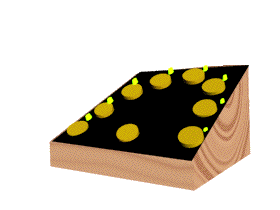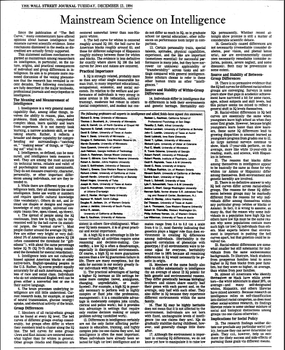
The Jensen box was developed by University of California, Berkeley psychologist Arthur Jensen as an experimental apparatus for measuring choice reaction time (RT) and individual differences in intelligence. [1]

The Jensen box was developed by University of California, Berkeley psychologist Arthur Jensen as an experimental apparatus for measuring choice reaction time (RT) and individual differences in intelligence. [1]
The standard Jensen box is approximately 12 by 20 inches in size with a sloping face. Eight buttons are arrayed in a semicircle with a 'home' key in the lower center. Above each response button is a small LED light. Following an auditory warning tone and a delay, one of the lights is illuminated and the participant releases their finger from the home button. Participants then move to initiate a button press at the illuminated location as quickly as possible.
RT is measured in two different ways: the time elapsed between the light signal and the home button release, and the time between the home button release and the target button press. These separate measures were initially conceptualized as assessing "decision time" and "movement time," respectively. However, participants can shift decision time into the movement phase by releasing the home button while the decision-making is still incomplete. Masking the stimulus light can eliminate this artifact. [2] Several additional parameters can be extracted. The slope of RTs when 1, 2, 4, and 8 light choices are presented is used to index the rate of information processing. Variance or standard deviation in intra-individual RTs can be extracted to measure individual differences in response variability.
Following Hick's law, [3] RTs slow as a function of the number of presented choices. Button presses are fastest when only one button is shown and slowest when all eight possible response buttons are available. Simple reaction time correlates with general cognitive ability, [4] and there is some evidence that the slope of responding on the Jensen box does as well. [2] Ian Deary and colleagues, in a population-based cohort study of 900 individuals, demonstrated correlations between IQ and simple choice RTs between –0.3 and –0.5. [4] The Jensen box has also been used on the Odd Man Out test.

Arthur Robert Jensen was an American psychologist and writer. He was a professor of educational psychology at the University of California, Berkeley. Jensen was known for his work in psychometrics and differential psychology, the study of how and why individuals differ behaviorally from one another.

An intelligence quotient (IQ) is a total score derived from a set of standardized tests or subtests designed to assess human intelligence. The abbreviation "IQ" was coined by the psychologist William Stern for the German term Intelligenzquotient, his term for a scoring method for intelligence tests at University of Breslau he advocated in a 1912 book.
Discussions of race and intelligence – specifically, claims of differences in intelligence along racial lines – have appeared in both popular science and academic research since the modern concept of race was first introduced. With the inception of IQ testing in the early 20th century, differences in average test performance between racial groups were observed, though these differences have fluctuated and in many cases steadily decreased over time. Further complicating the issue, modern science has shown race to be a social construct rather than a biological reality, and intelligence has no undisputed definition. The validity of IQ testing as a metric for human intelligence is itself disputed. Today, the scientific consensus is that genetics does not explain differences in IQ test performance between groups, and that observed differences are environmental in origin.
The g factor is a construct developed in psychometric investigations of cognitive abilities and human intelligence. It is a variable that summarizes positive correlations among different cognitive tasks, reflecting the fact that an individual's performance on one type of cognitive task tends to be comparable to that person's performance on other kinds of cognitive tasks. The g factor typically accounts for 40 to 50 percent of the between-individual performance differences on a given cognitive test, and composite scores based on many tests are frequently regarded as estimates of individuals' standing on the g factor. The terms IQ, general intelligence, general cognitive ability, general mental ability, and simply intelligence are often used interchangeably to refer to this common core shared by cognitive tests. However, the g factor itself is merely a mathematical construct indicating the level of observed correlation between cognitive tasks. The measured value of this construct depends on the cognitive tasks that are used, and little is known about the underlying causes of the observed correlations.
Hick's law, or the Hick–Hyman law, named after British and American psychologists William Edmund Hick and Ray Hyman, describes the time it takes for a person to make a decision as a result of the possible choices: increasing the number of choices will increase the decision time logarithmically. The Hick–Hyman law assesses cognitive information capacity in choice reaction experiments. The amount of time taken to process a certain amount of bits in the Hick–Hyman law is known as the "rate of gain of information". The plain language implication of the finding is that increasing the number of choices does not directly increase the time to choose. In other words, twice as many choices does not result in twice as long to choose. Also, because the relationship is logarithmic, the increase in time it takes to choose becomes less and less as the number of choices increases.
Neuroscience and intelligence refers to the various neurological factors that are partly responsible for the variation of intelligence within species or between different species. A large amount of research in this area has been focused on the neural basis of human intelligence. Historic approaches to study the neuroscience of intelligence consisted of correlating external head parameters, for example head circumference, to intelligence. Post-mortem measures of brain weight and brain volume have also been used. More recent methodologies focus on examining correlates of intelligence within the living brain using techniques such as magnetic resonance imaging (MRI), functional MRI (fMRI), electroencephalography (EEG), positron emission tomography and other non-invasive measures of brain structure and activity.

Ian John Deary OBE, FBA, FRSE, FMedSci is a Scottish psychiatrist known for work in the fields of intelligence, cognitive ageing, cognitive epidemiology, and personality.
The Simon effect is the difference in accuracy or reaction time between trials in which stimulus and response are on the same side and trials in which they are on opposite sides, with responses being generally slower and less accurate when the stimulus and response are on opposite sides. The task is similar in concept to the Stroop Effect. The Stroop Color and Word Test (SCWT) can be used to assess the ability to inhibit cognitive interference that occurs when the processing of a specific stimulus feature impedes the simultaneous processing of a second stimulus attribute. The Simon effect is an extension of this effect, but the interference in this task is generated by spatial features rather than features of the stimuli themselves.
The Minnesota Transracial Adoption Study examined the IQ test scores of 130 black or interracial children adopted by advantaged white families. The aim of the study was to determine the contribution of environmental and genetic factors to the poor performance of black children on IQ tests as compared to white children. The initial study was published in 1976 by Sandra Scarr and Richard A. Weinberg. A follow-up study was published in 1992 by Richard Weinberg, Sandra Scarr and Irwin D. Waldman. Another related study investigating social adjustment in a subsample of the adopted black children was published in 1996. The 1992 follow-up study found that "social environment maintains a dominant role in determining the average IQ level of black and interracial children and that both social and genetic variables contribute to individual variations among them."

Mental chronometry is the scientific study of processing speed or reaction time on cognitive tasks to infer the content, duration, and temporal sequencing of mental operations. Reaction time is measured by the elapsed time between stimulus onset and an individual's response on elementary cognitive tasks (ETCs), which are relatively simple perceptual-motor tasks typically administered in a laboratory setting. Mental chronometry is one of the core methodological paradigms of human experimental, cognitive, and differential psychology, but is also commonly analyzed in psychophysiology, cognitive neuroscience, and behavioral neuroscience to help elucidate the biological mechanisms underlying perception, attention, and decision-making in humans and other species.

"Mainstream Science on Intelligence" was a public statement issued by a group of researchers of topics associated with intelligence testing. It was published originally in The Wall Street Journal on December 13, 1994, as a response to criticism of the book The Bell Curve by Richard Herrnstein and Charles Murray, which appeared earlier the same year. The statement defended Herrnstein and Murray's controversial claims about race and intelligence.
An elementary cognitive task (ECT) is any of a range of basic tasks which require only a small number of mental processes and which have easily specified correct outcomes. Although ECTs may be cognitively simple there is evidence that performance on such tasks correlates well with other measures of general intelligence such as Raven's Progressive Matrices. For example, corrected for attenuation, the correlation between IQ test scores and inspection time is about 0.5. It has been found that when a battery of ECTs is factor analyzed, the general factor that emerges from this is strongly correlated with general intelligence extracted from traditional IQ batteries, and relates similarly to other variables.
Timothy C. Bates is a professor of differential psychology at the University of Edinburgh. His research interests include the genetics of reading and spelling, intelligence, and personality.
Inspection time refers to the exposure duration required for a human subject to reliably identify a simple stimulus. Typically a stimulus made up of two parallel lines differing in length and joined at the tops by a cross bar is presented. The ability to quickly detect the identity of a stimulus is moderately heritable and correlates with the subject's IQ.
Cognitive epidemiology is a field of research that examines the associations between intelligence test scores and health, more specifically morbidity and mortality. Typically, test scores are obtained at an early age, and compared to later morbidity and mortality. In addition to exploring and establishing these associations, cognitive epidemiology seeks to understand causal relationships between intelligence and health outcomes. Researchers in the field argue that intelligence measured at an early age is an important predictor of later health and mortality differences.
The Lothian birth-cohort studies are two ongoing cohort studies which primarily involve research into how childhood intelligence relates to intelligence and health in old age. The Lothian Birth Cohort studies of 1921 and 1936 have, respectively, followed up Lothian-based participants in the Scottish Mental Surveys of 1932 and 1947 in old age. Scottish Mental Survey data has provided a measure of the intelligence of Lothian Birth Cohort participants at age 11, which has enabled the investigation of how childhood intelligence relates to cognition, mental health and physical health in old age.

The Odd-Man-Out Reaction Time test is a test of reaction times that uses Arthur Jensen's testing apparatus, the Jensen box. The box is normally used for measuring choice reaction times in which the participant in the experiment is tested on their ability to recognize which of the eight lights of the Jensen box is illuminated, as quickly as possible. However, in the Odd Man Out Reaction Time test, three lights are illuminated in each trial. Two are close together and the other further apart; the individual being tested must identify this third light.
Intelligence and personality have traditionally been studied as separate entities in psychology, but more recent work has increasingly challenged this view. An increasing number of studies have recently explored the relationship between intelligence and personality, in particular the Big Five personality traits.
Wendy Johnson is an American differential psychologist and professor of psychology at the University of Edinburgh. She holds the chair in Differential Development in the Department of Psychology and Centre for Cognitive Ageing and Cognitive Epidemiology at the University of Edinburgh.
Jensenism is a term coined by New York Times writer Lee Edson. Named after educational psychologist Arthur Jensen, it was originally defined as "the theory that IQ is largely determined by the genes". The term was coined after Jensen published the article "How Much Can We Boost IQ and Scholastic Achievement?" in the Harvard Educational Review in 1969. It has since been included in several dictionaries.